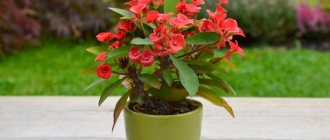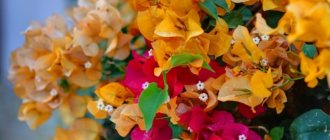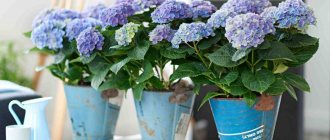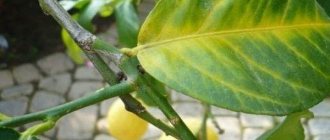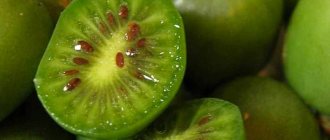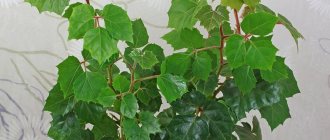Features of preparing actinidia for winter - general tips and recommendations
Therefore, whether the autumn care of actinidia is carried out correctly depends on whether the area will be decorated with openwork weaving of thin stems. To protect actinidia from its inherent diseases and prepare the plant for the arrival of cold weather, you need to perform the following actions.
Watering. It is necessary to moisten the climbing plant only in case of a long absence of rain. About 6-8 buckets of water are poured under the root of one plant.
Feeding. In the fall, organic matter or phosphorus-potassium fertilizers are applied under the exotic vine, and then the trunk circle is dug shallowly. To fertilize 1 sq.m, it will be enough to add 2-3 kg of rotted mullein or horse manure, 50 g of superphosphate, 15 g of potassium salt into the soil.
Instead of phosphate and salt, you can use multicomponent mineral fertilizers, which contain phosphorus and potassium and lack nitrogen. Actinidia can be fed with compost at the rate of 2-3 buckets per plant.
Important! The roots of the vine are located close to the surface, therefore, in order not to damage them, the turning depth should be less than 30 cm.
Trimming. During pruning, it is important not only to follow the manipulation technology, but also to take into account the characteristics of the cultivated variety. For example, actinidia arguta sets fruit exclusively on short branches, so to increase productivity, the vine needs to regularly shorten its shoots and thin out the crown more intensively.
You can pinch kolomikta branches only when the plant reaches the age of 7-10 years. Instead of pruning, the old vine is replaced with a young one.
Polygamy sets berries on shortened branches, so even cutting them off slightly will result in a decrease in yield.
Mulching. Since the roots of the climbing plant are shallow, the soil around the perimeter of the rhizome is covered with a layer of dry organic materials. You should start laying out peat or dry leaves immediately after the onset of constant cold weather.
Shelter. Three varieties of actinidia have gained popularity in our country: kolomikta, acute, polygamous. If the first variety is able to withstand temperatures down to -35C and winters well without shelter, then the other two varieties need careful insulation.
Video: preparing actinidia for winter in the fall.
Harvesting Actinidia
If you do everything correctly, then actinidia will begin to produce fruit from the age of three, sometimes it can bear fruit a year later. Of course, at first it will be just a few berries, then the yields will begin to increase and will reach their maximum by the age of six or seven years, and with systematic anti-aging pruning, the vine can bear fruit for several decades.
On good, nutritious soil, with sufficient moisture and good care, actinidia will produce up to sixty kilograms of delicious fruits from one bush. The fruits ripen at different times; sometimes, in order to collect the entire harvest, it is necessary to carry out up to five harvests. You shouldn’t rush and pick the first ripened actinidia berries, you can wait a little and harvest in two or three steps, but you shouldn’t delay it too much; overripe berries may begin to crumble. The first fruits of early varieties of actinidia usually ripen in mid-August, the last ones can be found on vines at the end of September. Immediately after harvesting the entire harvest, the vine can be fed; either wood ash in the amount of 250-300 g per bush or a tablespoon of potassium salt and superphosphate per bush is suitable for this.
Pruning in autumn
The peculiarity of actinidia pruning lies in the structure of the vine. The plant consists of 3 types of branches:
- Growth or vegetative. Such branches do not bear fruit.
- Vegetative-generative. Fruits are formed only at the top and bottom of the branch.
- Generative. The side shoots on which the bulk of the fruit is formed.
- prevent excessive crown density;
- increase resistance to diseases;
- activate the growth of new branches;
- increase the volume of the harvest and its quality;
- give the vine the desired shape.
When determining which species a shoot belongs to, you need to take into account the fact that the vine forms fruits only on the branches of the growing year.
Why trim
As soon as cold weather approaches, gardeners think about the advisability of removing branches. Due to ignorance of the intricacies of growing actinidia, many summer residents do not prune the plant, which has a very detrimental effect on the vine.
Pruning should be done in order to:
Judging by the number of positive properties that autumn pruning of actinidia carries, manipulation is necessary for the exotic plant for further development.
When is it better to prune - in spring or autumn?
The optimal time for pruning actinidia is in early spring, when the plant has not yet woken up, and in late autumn after shedding its leaves.
You should not delay the spring trimming: if you carry out the manipulation in April, when sap flow begins, the plant will secrete sap for a long time in the cut areas. Poorly healed wounds can cause the death of the vine.
Timing for pruning in autumn
As soon as stable sub-zero temperatures are established at night and the vine has shed all its leaves, you can begin autumn pruning. Depending on the weather of the climatic zone where actinidia is grown, the branches are removed in October-November.
Important! It is impossible to prune the vine before the specified time - due to the removal of branches when the sap flow has not yet ended, the plant will bleed sap for a long time, as a result of which it will become very weak and die.
How to properly prune actinidia in the fall - instructions and diagram
Due to the fact that actinidia grows shoots very quickly, in order to prevent the crown from becoming too thick, the vine must be pruned regularly. Proper pruning not only increases immunity to disease and improves productivity, but also makes actinidia more resistant to cold, which is very important when growing relatively heat-loving specimens.
Boy or girl?
Actinidia is a dioecious plant, that is, one plant can have both only male flowers and only female ones, like sea buckthorn flowers. Therefore, in order to get a harvest, representatives of both sexes of actinidia must be planted on the site. However, there are individuals that have both male and female flowers, but it’s not worth the risk; it’s better to trust professionals when choosing planting material. You can only understand what gender the actinidia seedling is in front of you during the flowering period by carefully examining the flowers: female specimens usually do not have stamens, and male specimens do not have pistils. There are, however, female flowers that have stamens, but they are poorly developed and have sterile (non-viable) pollen, while the pistil is much better developed.
Actinidia flowers form in the axils of leaf blades. During the flowering period, it is not always possible to notice the flowers; they seem to be hidden under the leaves. Sometimes, in order to see a flower or take a spectacular shot, you need to lift part of the vine. The flowering of actinidia is quite long, but it depends on the weather: if it is hot, then the flowers please the eye for no more than a week, if it is cool, then the flowering is brighter, the aroma is strong, and it lasts 10-12 days. After pollination, the ovary begins to develop, which ultimately turns into small actinidia fruits of an elongated shape and most often of a rich green color.
Actinidia fruits ripen towards the end of summer - beginning of autumn; when fully ripe, they soften and can be eaten. The taste resembles something between kiwi and strawberry, sometimes there is a pronounced strawberry aroma. Each berry is a storehouse of vitamins and minerals, but actinidia fruits contain especially high amounts of ascorbic acid - up to 3000 mg%, which is close in value to rose hips.
Actinidia flowering.
Shelter for the winter
The vast majority of species have very low cold resistance - when the temperature drops to -10C, the plant freezes completely. The remaining varieties, among which the most popular are Kolomikta and Geneva, are able to withstand temperatures dropping from -23 to -35 C.
Video: features of actinidia shelter for the winter.
Is it necessary to cover actinidia for the winter?
Whether or not to cover a vine for the winter depends on the variety and age of the plant. Species that do not have high frost resistance must be covered, otherwise heat-loving vines will freeze out in the middle of winter. Even if actinidia manages to survive extreme wintering, it will bear fruit poorly.
Regardless of the variety, vines planted this fall need insulation. Representatives of cold-resistant species can winter without shelter at all.
Disease and pest control
Although actinidia is highly resistant to diseases and pests, some problems may arise if not properly cared for. The most famous of them is fungus. At the same time, dark spots begin to appear on the leaves. If the plant is overwatered, it may develop gray mold or fruit rot. To reduce the risk of disease, it is recommended to spray with a solution of Bordeaux mixture for preventive purposes. Treatment with a solution of soda ash will help cope with powdery mildew.
What are the features of preparing for winter in the regions?
Depending on the variety and weather of the growing region, “kiwi” (as actinidia is popularly called) is covered in different ways. In order for the plant to overwinter well, you need to correctly determine the method of shelter, comparing the characteristics of the variety and environmental conditions.
In the middle lane
Adult actinidia kolomikta (garden) grown in this region overwinters without shelter. Actinidia acute and polygamous in the Moscow region are covered for the winter with mulch, which is applied with branches.
In the Volga region
Heat-loving varieties of actinidia are insulated from below and above with a layer of mulch, which is covered with building materials. To prevent mice from settling inside the shelter, rodent poison is placed near the branches.
In the Urals and Siberia
Due to the harsh climate in Siberia and the Urals, actinidia is insulated for the winter using the full cover method, which is described in detail above.
Planting in the ground, transplanting
When growing indoor actinidia from seeds, the first flowering is possible after an average of 5 years, but if the plant feels comfortable, this can happen earlier. In order for actinidia to bear fruit, it is necessary to have male and female plants nearby and ensure their cross-pollination. The sex of a plant can be determined just at the moment of flowering.
In nature, pollination occurs with the help of bees and the wind; at home, you will have to work as a bee yourself and carry out pollination by transferring pollen from plant to plant using a brush.
Actinidia can be grown from cuttings, layering and seeds. But since actinidia is not so popular among indoor plants. And it’s not so easy to buy a ready-made specimen at the nearest home flower store; let’s start by growing actinidia from seeds.
It is best to plant actinidia seeds in the spring (from March to May), it is at this time that the best germination of seeds is observed. And it is the plant grown from seeds that best adapts to the conditions of the room.
An important feature of planting actinidia is that only fresh seeds are suitable for sowing. To obtain such seeds, you need to take a good ripe kiwi fruit. At the same time, the variety of kiwi is not important, since anyone can grow at home.
The fruit should be divided into halves and approximately 20-30 dark grains should be extracted. These are the seeds for planting actinidia. It is not recommended to take fewer seeds, since, firstly, not all of them can sprout. Secondly, practice shows that 80% of sowing yields male plants, and for fruiting it is necessary to grow specimens of both sexes.
You need to remove the grains very carefully so as not to damage the shell. There are several ways to do this, but two of them are the most convenient. You can use tweezers and carefully, without pressing, remove the grains from the fruit. Or you can cut the kiwi into small pieces and pour warm water over them, after a while the grains will separate from the pulp.
The pulp must be removed and the water drained through cheesecloth, on which clean seeds will remain. When selecting seeds, it is important to ensure that no kiwi pulp remains on them, otherwise the seeds may rot. After selecting the seeds, they must be laid out on a clean surface and dried for at least four hours.
The next step is to germinate the seeds. To do this, take a small container, maybe a saucer, and line it with cotton wool (you can also take gauze). Pour boiling water over the cotton wool, but so that the cotton wool is wet and there is no excess water in the saucer. Place the seeds on cotton wool, cover the saucer with film and leave it on a light windowsill. Every evening we ventilate the seeds, removing the film for a while. In the morning we water the cotton wool and make sure that it is always wet. If all conditions are met, after about 1-2 weeks the seeds will appear the first sprouts in the form of small white roots. These seeds are ready to be planted in the soil.
The soil for actinidia should be the same as the soil for citrus crops. You can buy it at a garden store, or you can make it yourself. To do this, you need to mix two parts of chernozem, two parts of peat and one part each of river sand and humus. For the germination of seeds and young seedlings, it is extremely important that there is peat in the soil, because actinidia grows well and develops only in acidified soils. For older plants, the amount of peat can be reduced.
For the initial planting of seeds in the soil, it is better to choose oblong, shallow containers or pots. Subsequently, this will allow you to quickly and conveniently plant young plants without damaging the root system.
The bottom of the container must be covered with expanded clay, which will protect the crops from excess moisture. Soil is poured on top of the expanded clay, in which small holes are made with a depth of no more than one centimeter. The seeds are placed in the holes and sprinkled with soil; there is no need to compact the soil.
The container with the crops is covered with film or glass (special mini-greenhouses can also be used) and placed in a warm place to create a greenhouse effect. It is necessary to water the crops daily and not allow the soil to dry out. As soon as the first shoots appear, you need to start ventilating the crops. To do this, you need to remove the film for some time every day, increasing this time every day.
After about 3-4 weeks, the first leaves will begin to appear on the seedlings. When the plants already have several full-fledged leaves, this is a sign that the actinidia can be transplanted to another place, that is, into separate pots.
It is also necessary to fill the bottom of each pot with drainage, and when preparing the soil for grown actinidia, you can reduce the amount of peat and increase the amount of chernozem. When planting actinidia, you need to be very careful with the roots; in vines they are delicate and easy to damage. Plant placement is necessary so that the grown actinidia leaves (and they are quite large) do not shade each other, and the young, immature plant has enough light.
Actinidia is not transplanted at home for the first 2-3 years. In this case, the size of the plant is adjusted by pruning. Subsequently, it is necessary to observe the behavior of the plant; if it apparently slows down its growth, it means it is becoming crowded and needs a larger pot. It is better to choose a pot that is wide in diameter, but not very deep, since the roots of the vines are located on the surface. In practice, an adult plant is replanted once every 3-4 years.
Since actinidia is a climbing plant and its stems are quite thin, it is necessary to install a support in the pots with the plant. There can be many options for support, but in an indoor version, to form a beautiful weaving plant, it is best to install bamboo sticks around the circumference of the pot, and as the plant grows, weave the support horizontally with something rigid, for example, wire.
If a cat lives in your house or apartment, when arranging young actinidia seedlings, you should also take into account the accessibility of the plant to your pet. The fact is that young shoots of actinidia emit a peculiar smell that attracts cats. The animal, in turn, showing interest in the plant, can seriously damage it.
Typical mistakes in autumn care and preparation for winter
To avoid the painful appearance and death of the plant caused by incorrect actions during preparation for winter, below are the most common mistakes in caring for actinidia in the fall.
- All varieties are pruned according to the same pattern. When removing branches, you need to take into account the characteristics of the variety being grown, since their representatives may react differently to the same action.
- They do not comply with shelter deadlines. Warming too early ends in the death of the vine.
- The liana is pruned during active sap flow. Wounds after untimely pruning do not heal, and the vine slowly bleeds juice and dies.
To keep actinidia on your site until the next season, you need to properly care for it in the fall - trim it in a timely manner and properly cover it for the winter.
The care provided will be rewarded with openwork decoration of the site throughout the summer and an abundant harvest of useful fruits. Did you like the article? Share with friends on social networks:

